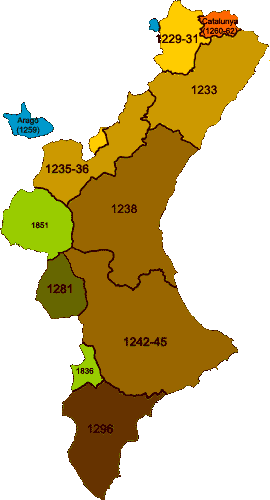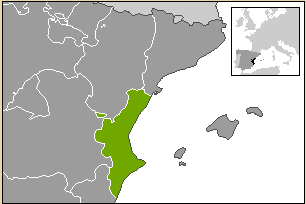Kingdom of Valencia facts for kids
Quick facts for kids
Kingdom of Valencia
Regne de València (in Valencian)
Reino de Valencia Regnum Valentiae |
|||||||||||
|---|---|---|---|---|---|---|---|---|---|---|---|
| 1238 – 1707 | |||||||||||

Kingdom of Valencia and its administrative structure
|
|||||||||||
| Status | Realm of the Crown of Aragon | ||||||||||
| Capital | Valencia | ||||||||||
| Common languages | Valencian, Aragonese, Castilian, Andalusi Arabic and Latin | ||||||||||
| Religion |
|
||||||||||
| Government | Monarchy | ||||||||||
| King | |||||||||||
|
• First
|
James I of Aragon | ||||||||||
|
• Last
|
Philip V of Spain | ||||||||||
| Legislature | Valencian Courts | ||||||||||
| Historical era | Medieval / Early modern | ||||||||||
|
• Established
|
1238 | ||||||||||
| 1707 | |||||||||||
|
|||||||||||
| Today part of | Spain | ||||||||||
The Kingdom of Valencia (called Regne de València in Valencian) was an important part of the Crown of Aragon. It was located on the eastern coast of the Iberian Peninsula, which is where Spain and Portugal are today. Later, when the Crown of Aragon joined with the Crown of Castile to form the Kingdom of Spain, Valencia became a part of the new Spanish monarchy.
This kingdom officially began in 1238. This was after the Reconquista, a long period when Christian kingdoms took back land from Muslim rulers in Spain. The city of Valencia, which was then a Muslim kingdom called a taifa, was captured. The Kingdom of Valencia lasted until 1707. It was ended by Philip V of Spain through laws called the Nueva Planta decrees, after a big fight known as the Spanish War of Succession.
During its time, the Kingdom of Valencia had its own laws and government, called the Furs. These laws gave it a lot of self-rule under the Crown of Aragon and later under the Spanish Kingdom. The area that is now the Valencian Community in Spain is largely the same as the old Kingdom of Valencia.
Contents
How the Kingdom Was Formed
The story of how the Kingdom of Valencia was created began in 1232. King James I of the Crown of Aragon, also known as Jaume I el Conqueridor (the Conqueror), started taking land from Muslim rulers. He first captured the town of Morella with his army. Soon after, in 1233, his forces also took Borriana and Peniscola. These towns were part of the Muslim kingdom of Balansiyya (Valencia).
The biggest step happened in 1238. King James I defeated the Muslim rulers of Balansiyya. He proudly entered the city of Valencia on October 9, 1238. This date is seen as the official start of the Kingdom of Valencia.
More land was taken between 1243 and 1245. King James I and Alfonso the Wise, who would become King of Castile, agreed on a border. This border was set in the Treaty of Almizra. This treaty helped the Christian kingdoms work together to push south against the Muslim lands. It set the southern border of Aragon's expansion at the towns of Biar and Busot. Any land south of this line, including the area of Kingdom of Murcia, was reserved for Castile.
Challenges with the Muslim Population
After the Christian conquest, many Muslims, called Mudéjars, stayed in the kingdom. They were very important for the economy because they were a large part of the population. However, they were also seen as a threat. There were worries they might not be loyal or might try to get help from the Ottoman Empire.
Muslims often rebelled against Christian rule. The most famous leader of these revolts was Al-Azraq. He led major rebellions in 1244, 1248, and 1276. In one revolt, King James I almost died in battle. Al-Azraq was eventually defeated but his life was spared. He was killed in the third rebellion, but his son continued to cause trouble.
Expanding the Borders South
In 1296, King James II, a grandson of James I, pushed his army even further south. He aimed for the rich farmlands around Murcia and the Vega Baja del Segura. These areas were ruled by local Muslim leaders who had agreements with Castile.
King James II's campaign was very successful. It extended the Kingdom of Valencia's borders far south of the original agreement with Castile. His troops captured Orihuela and Murcia. The final border between Castile and Aragon was set by the Sentencia Arbitral de Torrellas (1304) and the Treaty of Elche (1305). These treaties gave Orihuela, Alicante, and Elche to the Kingdom of Valencia. Murcia went to Castile. This created the final southern border of the Kingdom of Valencia.
By the end of this process, four Muslim kingdoms (taifas) had been taken over: Balansiya, Alpuente, Denia, and Murcia. This was a very fast conquest for its time. Most of the land was gained in less than 50 years. However, this quick expansion also meant that a large Muslim population remained inside the new Christian kingdom.
Building the Kingdom
Historians today see the conquest of Valencia as a way for the king to gain new lands. These lands would be directly under the king's control, not under the power of the nobles. This helped the king become stronger than the powerful noble families. This was a common trend in medieval Spain.
The king wanted to free himself from the nobles' control, but it was not easy. The nobles had a lot of power and wanted to keep it. When the new lands were settled by Christians, the king gave some areas to Aragonese nobles. But these were mostly mountainous and less populated parts of the kingdom. The king kept the fertile, more populated coastal areas for free citizens and a growing middle class. These cities were given Furs, or royal charters. These charters set up local laws and government, but the cities still answered to the king.
Languages in the Kingdom
This way of settling the land had an impact on the languages spoken.
- People from the Kingdom of Aragon, who spoke an old form of the Aragonese language, mostly settled the inland areas. This language was related to the Spanish language.
- People from Principality of Catalonia, who spoke Catalan, mostly settled the coastal areas. This language is part of the Occitano-Romance group. Many believe that the language of these settlers became the modern Valencian language, which is considered a form of Catalan.
Some people have suggested that the conquerors' languages mixed with a local Romance language called Mozarabic, which was already similar to Catalan. However, there isn't strong proof for this idea.
Golden Age of Valencia
The Kingdom of Valencia was at its strongest in the early 15th century. Its economy was thriving, especially through trade across the Mediterranean Sea. The Crown of Aragon, with its important ports in Valencia and Barcelona, controlled much of this trade.
In the city of Valencia, a special bank and stock exchange called the Taula de canvi was created. This helped trade grow even more. Local industries, especially textile making, became very successful. Valencia became a major trading hub in the Mediterranean, attracting traders from all over Europe. A great symbol of this rich period is the Silk Exchange. It's a beautiful example of Gothic architecture and was a key trading market in the 15th and 16th centuries.
Valencia was also one of the first European cities to get a movable type printing press, based on Johannes Gutenberg's ideas. Famous Valencian writers like Joanot Martorell and Ausiàs March created classic works in the Valencian language.
Later Years and Decline
In 1479, Ferdinand became King of Aragon. He had already married Queen Isabella I of Castile. This marriage created the modern Kingdom of Spain. Valencia slowly became more connected with the rest of Spain. When their grandson Charles became king, the crowns were permanently joined. The kings of Habsburg Spain (1516–1700) kept the special rights and laws of Valencia. A new position, Viceroy of Valencia, was created to manage the kingdom, which was still officially independent.
Meanwhile, the Spanish Empire grew into a Great power. It started focusing more on its new lands in the Americas and its European possessions, rather than its territories in Spain.
During the 16th century, Valencia's importance as a trading center declined. Cities in Northern and Central Europe, and later cities in Andalusia like Cádiz, became more important for trade. This was because profits from Mediterranean trade went down. The Spanish Empire often fought with the Ottoman Empire, which controlled much of the eastern Mediterranean. Also, Barbary pirates from North Africa attacked trade ships and raided Christian ports. This hurt Valencia's economy. The economy had already been affected when the Jews were expelled from Spain in 1492 by the Alhambra decree.
The Germanies Revolt
In 1519, the young King Charles I allowed the Germanies (meaning "brotherhoods") to arm themselves. These were groups of artisans who acted as civilian militias to fight off Muslim pirates. However, the Germanies also had their own goals. They wanted more power for common people and guilds, which clashed with the rich nobles.
In 1520, the Viceroy of Valencia Diego Hurtado de Mendoza refused to let officials who supported the Germanies take their seats. This led to a full-scale rebellion called the Revolt of the Brotherhoods (Revolta de les Germanies). It lasted until 1522. The rebels were angry at the nobles and also had strong anti-Muslim feelings. They blamed Muslims for a plague and saw them as allies of the nobles. During the revolt, the agermanats (rebels) killed many Muslims and forced others to be baptized. Even after the revolt was put down, these forced baptisms were considered valid, which led to another revolt by the Moriscos (Muslim "converts").
After these fights between nobles and common people, the king became more powerful. He gradually reduced the power of local authorities. This meant he asked for more money from Valencia to support his wars in Europe. In return, Valencia received less support from the king.
The expulsion of the Moriscos in 1609 was a huge blow to Valencia's economy. Tens of thousands of people, mostly farmers working for the nobles, were forced to leave. Whole villages became empty, and the countryside lost its main workforce. About 125,000 people left the land. While many Valencian citizens supported the expulsion, it caused a massive economic problem. The nobles lost their cheap labor. To get the king's protection for their privileges, the nobles and rich middle class slowly gave up their power to check the king's authority. This meant the kingdom's self-rule began to disappear.
The Kingdom of Valencia as a separate legal and political entity finally ended in 1707. This happened because of the Spanish War of Succession. Most Valencians supported Archduke Charles, who wanted to keep the old laws. But his side was completely defeated at the Battle of Almansa, near Valencia's borders. As a result, the Nueva Planta Decrees were passed. The new King Philip V of Spain of the House of Bourbon created a more centralized Spain, ending the independent parliaments of the Crown of Aragon, including Valencia's.
See also
 In Spanish: Reino de Valencia para niños
In Spanish: Reino de Valencia para niños
- Conquest of Valencia by El Cid
- List of Valencian monarchs
- Generalitat Valenciana
- Valencian Parliament
- Palace of the Borgias






